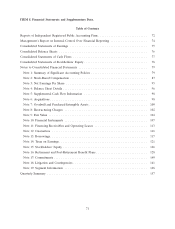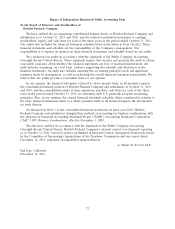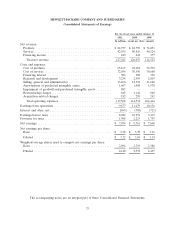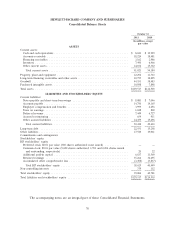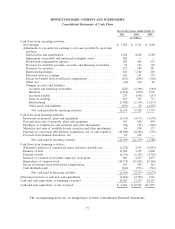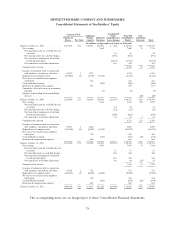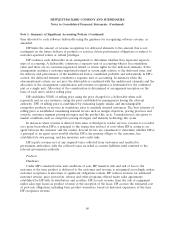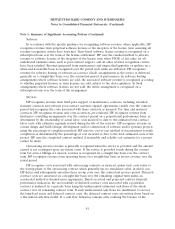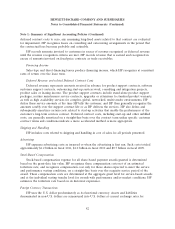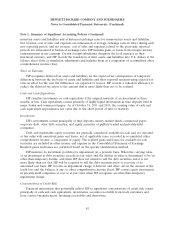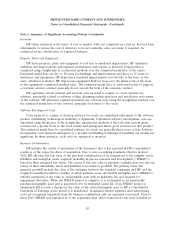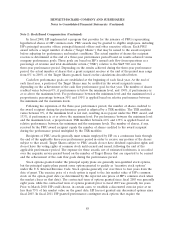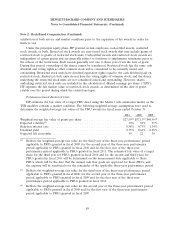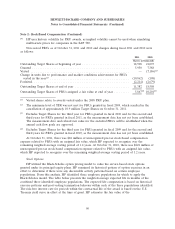HP 2011 Annual Report Download - page 89
Download and view the complete annual report
Please find page 89 of the 2011 HP annual report below. You can navigate through the pages in the report by either clicking on the pages listed below, or by using the keyword search tool below to find specific information within the annual report.HEWLETT-PACKARD COMPANY AND SUBSIDIARIES
Notes to Consolidated Financial Statements (Continued)
Note 1: Summary of Significant Accounting Policies (Continued)
Software
In accordance with the specific guidance for recognizing software revenue, where applicable, HP
recognizes revenue from perpetual software licenses at the inception of the license term assuming all
revenue recognition criteria have been met. Term-based software license revenue is recognized on a
subscription basis over the term of the license entitlement. HP uses the residual method to allocate
revenue to software licenses at the inception of the license term when VSOE of fair value for all
undelivered elements exists, such as post-contract support, and all other revenue recognition criteria
have been satisfied. Revenue generated from maintenance and unspecified upgrades or updates on a
when-and-if-available basis is recognized over the period such items are delivered. HP recognizes
revenue for software hosting or software-as-a-service (SaaS) arrangements as the service is delivered,
generally on a straight-line basis, over the contractual period of performance. In software hosting
arrangements where software licenses are sold, the associated software revenue is recognized according
to whether perpetual licenses or term licenses are sold, subject to the above guidance. In SaaS
arrangements where software licenses are not sold, the entire arrangement is recognized on a
subscription basis over the term of the arrangement.
Services
HP recognizes revenue from fixed-price support or maintenance contracts, including extended
warranty contracts and software post-contract customer support agreements, ratably over the contract
period and recognizes the costs associated with these contracts as incurred. For time and material
contracts, HP recognizes revenue and costs as services are rendered. HP recognizes revenue from
fixed-price consulting arrangements over the contract period on a proportional performance basis, as
determined by the relationship of actual labor costs incurred to date to the estimated total contract
labor costs, with estimates regularly revised during the life of the contract. HP recognizes revenue on
certain design and build (design, development and/or construction of software and/or systems) projects
using the percentage-of-completion method. HP uses the cost-to-cost method of measurement towards
completion as determined by the percentage of cost incurred to date to the total estimated costs of the
project. HP uses the completed contract method if reasonable and reliable cost estimates for a project
cannot be made.
Outsourcing services revenue is generally recognized when the service is provided and the amount
earned is not contingent upon any future event. If the service is provided evenly during the contract
term but service billings are uneven, revenue is recognized on a straight-line basis over the contract
term. HP recognizes revenue from operating leases on a straight-line basis as service revenue over the
rental period.
HP recognizes costs associated with outsourcing contracts as incurred, unless such costs relate to
the startup phase of the outsourcing contract which generally has no standalone value, in which case
HP defers and subsequently amortizes these set-up costs over the contractual services period. Deferred
contract costs are amortized on a straight-line basis over the remaining original term unless an
accelerated method is deemed more appropriate. Based on actual and projected contract financial
performance indicators, the recoverability of deferred contract costs associated with a particular
contract is analyzed on a periodic basis using the undiscounted estimated cash flows of the whole
contract over its remaining contract term. If such undiscounted cash flows are insufficient to recover
the long-lived assets and deferred contract costs, the deferred contract costs are written down based on
a discounted cash flow model. If a cash flow deficiency remains after reducing the balance of the
81


